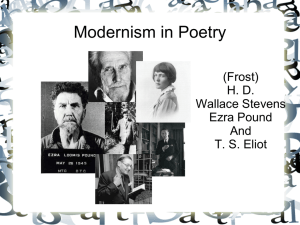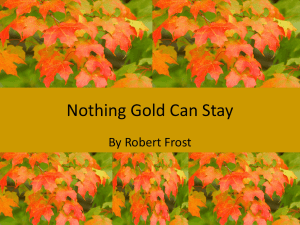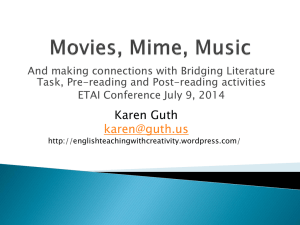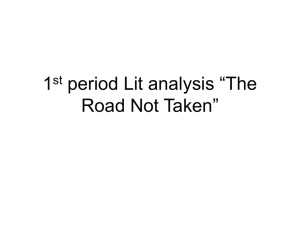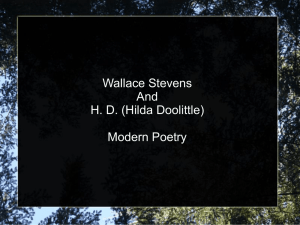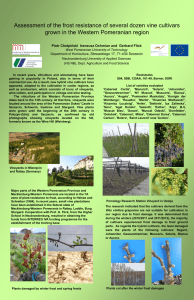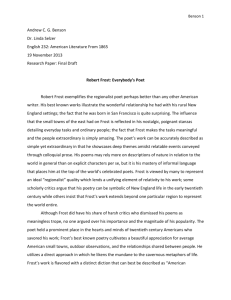Frost`s "Birches" and Modern Poetry
advertisement
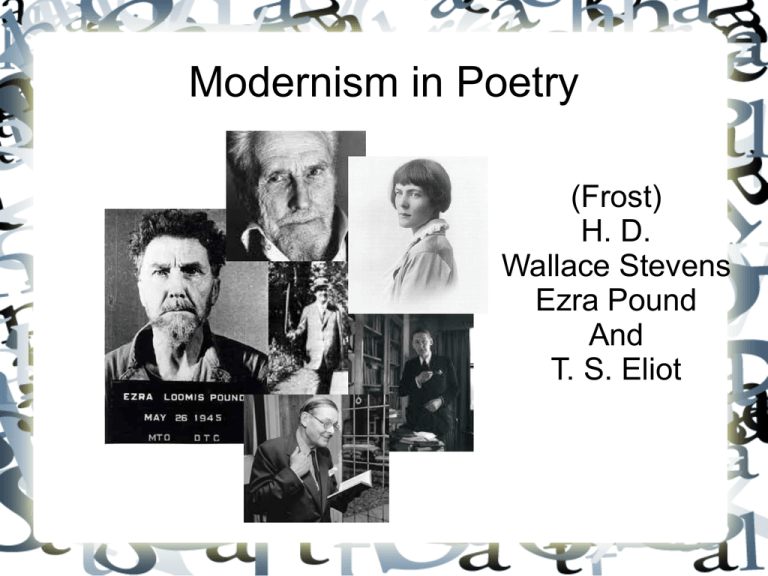
Modernism in Poetry (Frost) H. D. Wallace Stevens Ezra Pound And T. S. Eliot Modernity vs. Modernism Modernity Begins as early as the age of Shakespeare and Machiavelli (the late 1500s to the early 1600s). To speak correctly, we should speak of things that happen in our day as being “contemporary” to ourselves. “Modern” does not exactly mean “today”. Modern in Relation to Poetry Refers to characteristics such as A break with traditional forms A sense of creating a world as we perceive it A sense of historical discontinuity (break with history) A sense of alienation, despair and loss. Modernism in Poetry Rejects history and its society Rejects traditional values and assumptions Rejects the rhetoric that promotes the values and assumptions Elevates the individual and inner being over the social human being Prefers the unconscious to the self-conscious It is a reaction against realism and naturalism From holman and Harmon. A Handbook to Literature. “Modern.” Fifth Edition. What does that mean for the poetry? Read “Birches” by Frost “13 Ways of Looking at a Blackbird” by Wallace Stevens “Oread” by H.D. (Hilda Doolittle) They feel different and are different. First: Frost Frost writes at the same general time as the moderns Yet he is more traditional in many ways The form is more traditional He provides a context for the meaning of his poems. Mending Wall “Mending Wall” deals with some modern questions such as dealing with one's neighbors and society. The poem, though, has a setting and something of a beginning, middle and end. We can argue about the “message”, but there seems to be a message. Birches Also deals with “modern” issues of wanting to escape a harsh world. The poem has Context for meaning (a speaker reflecting on swinging birches and the imagination) A seeming message rather than just an image Birches: Meaning and Context We are into the poetry now, so let's go line by line OPEN YOUR BOOK and MARK THE LINES Birches is on page 399 For the easiest grasp of this poem, just follow me step by step, and then I'll post a video to recap First six lines When I see birches bend to left and right Across the lines of straighter darker trees, I like to think some boy's been swinging them. But swinging doesn't bend them down to stay As Ice-storms do. Often you must have seen them Loaded with ice a sunny winter morning . . . Note that Frost starts with what he would like to think. He is reacting against realism and naturalism. . . . London would just freeze the trees and the boy. Frost wants to think happy thoughts. Lines 7 – 18 (see book) The lines are beautiful but factual. The ice storm is really what bends the trees. Yet, Frost keeps heaven in our minds with The sun's warmth Crystal shells The inner dome of heaven. Different from London Frost refers to the ice melting and crashing down from the trees: Soon the sun's warmth makes them shed crystal shells Shattering and avalanching on the snow-crust – Such heaps of broken glass to sweep away You'd think the inner dome of heaven had fallen. Think back to the snow falling from the tree in London's story and how differently the description felt. Here we are reminded of something higher. Lines 19 – 41 (see book) Frost's speaker returns to fanciful explanations: The trees bend like girls drying their hair. Or, as he would prefer, they are bent by a boy who had learned to climb as far to the top as possible before returning to earth. Frost is not a romantic Frost is between the thorough modernists and the romantics, and reacts against the realists, while not ignoring reality. He is not a romantic because he acknowledges scientific fact. He says, But I was going to say when Truth broke in With all her matter-of-fact about the ice-storm . . .(21-22). He is almost poking fun at writers like London with his capital T in Truth in line 21. Is scientific fact the Truth for Frost? Is there nothing transcendent? The rest of the poem seems to hint at a higher truth that the poet reaches for. Lines 41 – 50 (see book) The speaker says he once was a swinger of birches and wishes to be again. What does he mean? Does he want to be a child and climb trees? In what context does he want to climb? When life is like a pathless wood When scientific fact (cobwebs and twigs in the face) are a pain That makes no sense He wants to climb trees to get away from twigs and cobwebs! NO! He wants to get away from earth awhile Here climbing the tree means more than climbing a tree (or it is really ridiculous because he wants to climb trees to get out of the woods). When the “factual” stuff of life gets to be too much he wants to get away from “earth.” Lines 49 - End I'd like to get away from earth awhile And then come back to it and begin over. May no fate willfully misunderstand me And half grant what I wish and snatch me away Not to return. Earth's the right place for love. The speaker wants a way to escape to something higher (like heaven), but not to die. He seeks some insight or inspiration that is toward heaven. Poets on Poetry As you reflect on the poem, what are you thinking? Are you distracted by children, bills, the washing machine, or your phone? IN the poem Frost lets us climb toward heaven and BE the boy swinging the birches IN THE PROCESS OF READING. If we can find time, quiet and space, we can escape with Frost into the “heavens” or into the world of the ice-storm, or the boy in the country playing. Frost on “swinging birches” Creating or reading and contemplating poetry are ways of climbing the birch tree We transcend the world of matter of fact and find some higher truth (imagination or inspiration) Truth exists beyond the human being Still, earth is the right place for human beings Frost differs from realists/naturalists Frost Finds truth in something more than fact London Reduces the experience of “the man” to a merely natural experience Frost is like the modernist poets In his rejection of naturalism and realism. Yet, he acknowledges the realities of nature. Unlike the Romantics, Frost presents a nature that has twigs and spiderwebs that hurt one's face. Frost NOT a modernist . . .? Frost, though, is clearly different from Wallace Stevens and H.D. Turn to “13 Ways of Looking at a Blackbird” and “Oread” (continued on next power point)
